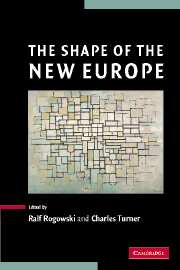Book contents
- Frontmatter
- Contents
- List of Contributors
- Acknowledgements
- 1 Europe: Law, Politics, History, Culture
- Part I Constitutionality and Political Participation
- Part II European Polity and European Civil Society
- Part III European History and European Culture
- 6 Plaidoyer pour l'Europe des Patries
- 7 Europe Becoming: The Civilisational Consequences of Enlargement
- 8 Gaia and Europa: Religion and Legitimation Crisis in the ‘New Europe’
- 9 A Postnational Council of Isles? The British–Irish Conflict Reconsidered
- Part IV Europe and The World
- Index
- References
6 - Plaidoyer pour l'Europe des Patries
Published online by Cambridge University Press: 22 September 2009
- Frontmatter
- Contents
- List of Contributors
- Acknowledgements
- 1 Europe: Law, Politics, History, Culture
- Part I Constitutionality and Political Participation
- Part II European Polity and European Civil Society
- Part III European History and European Culture
- 6 Plaidoyer pour l'Europe des Patries
- 7 Europe Becoming: The Civilisational Consequences of Enlargement
- 8 Gaia and Europa: Religion and Legitimation Crisis in the ‘New Europe’
- 9 A Postnational Council of Isles? The British–Irish Conflict Reconsidered
- Part IV Europe and The World
- Index
- References
Summary
The shape of the new Europe is best appreciated through a particular understanding of the old Europe. My use of these terms does not coincide with Donald Rumsfeld's contrast – designed to divide so as to better control Europe – between the key pioneers of European integration and newer members from Central Europe. Attention focuses instead on the historical sociology of European territory and institutions over the last century. What matters most of all is the national question, for reasons so obvious that they can be stated immediately with both bluntness and force.
The central feature that differentiated the old Europe of a century ago from its contemporary variant was the presence of multinational empires, most notably those of the Habsburgs, Romanovs and Ottomans. These authoritarian regimes were faced with the challenge of modernity, that is, with the complex intertwining of nationalism, democratisation and industrialisation, the precise contours of which we still do not fully understand. None was able to meet this challenge intact; all fragmented into a series of separate nation-states, albeit dissolution in the Russian case was much delayed by the empire being placed under new management at the end of the First World War. The tectonic shift caused by the ending of imperial rule in the European heartland resulted in vicious practices of ethnic cleansing, population transfer and genocide, all carried out in the midst of the fog of world wars. Accordingly, it is entirely appropriate to call twentieth century Europe ‘the dark continent’.
- Type
- Chapter
- Information
- The Shape of the New Europe , pp. 107 - 124Publisher: Cambridge University PressPrint publication year: 2006



